Low-Pressure Steam Generation with Concentrating Solar Energy and Different Heat Upgrade Technologies: Potential in the European Industry
Abstract
:1. Introduction
2. Methods
2.1. Technologies Addressed
2.2. Modeling Approach, Parameters, and Inputs
- Time-dependent inputs such as the thermal demand;
- Country-dependent parameters (e.g., energy prices);
- Technical model;
- Economic model;
- Key Performance Indicators (main outputs such as the payback period).
2.2.1. Time-Dependent Inputs
2.2.2. Country-Dependent Parameters
2.2.3. Technical Model
2.2.4. Economic Model
2.2.5. Key Performance Indicators
3. Results
3.1. Detailed Results for Spain for Process Heat Generation at 120 °C
3.2. Overall Results in Europe for Process Heat Generation at 120 °C
3.3. Overall Results in Europe for Process Heat Generation at 150 °C
4. Conclusions
- Despite their simplicity and relatively low CAPEX, EBs are not economically feasible in Europe with the current energy prices, with the single exception of Sweden, which is the country with the lowest electricity-to-gas price ratio.
- SHIP systems differ from the other alternatives since they are not self-sufficient. On days with a low DNI, they require a backup, which, in this case, is a GB. In Spain, for instance, an annual solar coverage demand of 31% was reached. The remaining 69% is ensured by a backup GB, which is a significant penalty in terms of the potential reduction in CO2 emissions. In countries with high DNI values, such as Spain, the SHIP system can reduce CO2 emissions by 31%, reaching a LCOH of 13 c€/kWh, which is lower than with the GB (17 c€/kWh). In general, countries with DNI values above 1400 kWh/m2/year have, using SHIP systems, PBs of around 4 to 5 years. This is the case in countries such as Greece, Spain, Italy, Portugal, and Romania. SHIP systems can play a key role in reducing the industrial carbon footprint given that they are capable of reaching higher temperatures (150 to 400 °C) than HTHPs or AHTs.
- HTHPs can attain PBs of less than four years for process heat supply temperatures of 120 °C. Their economic feasibility is more sensitive to the electricity cost than AHTs. HTHPs require electricity-to-gas cost ratios of a maximum of 3.5 with waste heat temperatures of 80 °C or a maximum cost ratio of 2.8 if the waste heat is available at only 60 °C. For process heat at 150 °C, if waste heat is available at 60–80–100 °C, the maximum cost ratio is 2.20–2.50–3.00, respectively. For process heat supply at 150 °C, PBs of 0.6 to 10.9 years can be reached in Europe. PBs below 1.5 years can be achieved in countries with electricity-to-gas price ratios below two. This is the case in countries such as Latvia, Hungary, Sweden, and Switzerland.
- AHTs reach the lowest CO2 emissions, LCOH, and CO2 emissions. However, the operating temperature ranges are narrower than with the HTHP. For instance, for process heat at 120 °C, the minimum waste heat temperature required is 80 °C, whereas for process heat at 150 °C, waste heat at 100 °C would be required, and this is less frequent in industry. With these temperatures, LCOH values in the range of 2 to 4 c€/kWh could be potentially achieved. In terms of PB values, the range in all European countries is 0.7 to 2.2 years for process heat at 120 °C and waste heat at 80 °C, and 0.6 to 2.5 years for process heat at 150 °C and waste heat at 100 °C.
Author Contributions
Funding
Data Availability Statement
Conflicts of Interest
Nomenclature
| c | Cost [EUR] |
| CAPEX | Capital expenditures [EUR] |
| COP | Coefficient of Performance [-] |
| d | Market discount rate [%] |
| DNI | Direct Normal Irradiation [kWh/m2/year] |
| DPP | Discounted payback period [years] |
| i | Mean inflation rate [%] |
| LCOH | Levelized cost of heat [EUR/kWh] |
| ɳ | Thermal efficiency [-] |
| NPV | Net Present Value [EUR] |
| OPEX | Operating expenditures [EUR] |
| PB | Payback period [years] |
| Q | Heat [W] or [Wh] if “annual” is specified as subindex |
| Qnet_solar_heat | Net solar heat produced by the SHIP system [Qh] |
| relec_CO2 | Mean emitted CO2 emissions of the electricity grid [ton/kWh] |
| rgas_CO2 | CO2 emissions due to gas consumption [0.000234 ton/kWh] |
| T | Temperature [°C] |
| W | Power [W] or Energy [Wh] if “annual” is specified as subindex |
| Yn | Year n in the economic analysis [year] |
| φcomp | Thermal losses percentage of the compressor [%] |
| Subscripts: | |
| amb | Ambient |
| annual | Annual |
| boiler | Boiler |
| CO2 | Carbon dioxide |
| demand | Thermal demand of process heat |
| elec | Electricity or electrical |
| energy | Energy consumption (gas or electricity) of each scenario |
| gas | Gas |
| in | Inlet |
| out | Outlet |
| Replacement | Replacing the reference GB with an alternative technology |
| scenario | Case assessed: GB, EB, SHIP, HTHP, or AHT |
| sink | Heat sink |
| source | Waste heat energy source of the HUTs |
| th | Thermal |
| Abbreviations: | |
| O&M | Operation and Maintenance |
| AHT | Absorption Heat Transformer |
| EB | Electric Boiler |
| EES | Engineering Equation Solver |
| GB | Gas Boiler |
| HTHP | High-Temperature Heat Pump |
| HUT | Heat Upgrade Technology |
| KPI | Key Performance Indicator |
| LFR | Linear Fresnel collectors |
| SHIP | Solar Heat for Industrial Processes |
References
- de Boer, R.; Marina, A.; Zühlsdorf, B.; Arpagaus, C.; Bantle, M.; Wilk, V.; Elmegaard, B.; Corberan, J.; Benson, J. Strengthening Industrial Heat Pump Innovation, Decarbonizing Industrial Heat. 2020. Available online: https://sintef.brage.unit.no/sintef-xmlui/bitstream/handle/11250/2764774/WhitePaper_HTHP_InudstrialHeatPump.pdf?sequence=2 (accessed on 17 February 2024).
- European Commission European Grean Deal Long Term Strategy 2050. Available online: https://ec.europa.eu/clima/eu-action/climate-strategies-targets/2050-long-term-strategy_es (accessed on 17 February 2024).
- Dadi, D.; Introna, V.; Benedetti, M. Decarbonization of Heat through Low-Temperature Waste Heat Recovery: Proposal of a Tool for the Preliminary Evaluation of Technologies in the Industrial Sector. Sustainability 2022, 14, 12626. [Google Scholar] [CrossRef]
- Dengler, J.; Köhler, B.; Dinkel, A.; Bonato, P.; Azam, N.; Kalz, D. Mapping and Analyses of the Current and Future (2020–2030) Heating/Cooling Fuel Deployment (Fossil/Renewables). Work Package 2: Assessment of the Technologies for the Year 2012. 2016. Available online: https://energy.ec.europa.eu/system/files/2016-04/Summary%2520WP1%2520and%2520WP2_0.pdf (accessed on 17 February 2024).
- Fox, D.B.; Sutter, D.; Tester, J.W. The Thermal Spectrum of Low-Temperature Energy Use in the United States. Energy Environ. Sci. 2011, 4, 3731–3740. [Google Scholar] [CrossRef]
- Arpagaus, C.; Bless, F.; Uhlmann, M.; Schiffmann, J.; Bertsch, S.S. High Temperature Heat Pumps: Market Overview, State of the Art, Research Status, Refrigerants, and Application Potentials. Energy 2018, 152, 985–1010. [Google Scholar] [CrossRef]
- Office of Energy Efficiency & Renewable Energy. U.S. Manufacturing Energy Use and Greenhouse Gas Emissions Analysis. 2012. Available online: https://www.energy.gov/sites/default/files/2013/11/f4/energy_use_and_loss_and_emissions.pdf (accessed on 17 February 2024).
- McMillan, C.A.; Ruth, M. Using Facility-Level Emissions Data to Estimate the Technical Potential of Alternative Thermal Sources to Meet Industrial Heat Demand. Appl. Energy 2019, 239, 1077–1090. [Google Scholar] [CrossRef]
- Kempener, R.; Saygin, D. Renewable Energy in Manufacturing—A Technology Roadmap for REmap 2030; International Renewable Energy Agency (Rena): Abu Dhabi, United Arab Emirates, 2014. [Google Scholar]
- Kosmadakis, G.; Arpagaus, C.; Neofytou, P.; Bertsch, S. Techno-Economic Analysis of High-Temperature Heat Pumps with Low-Global Warming Potential Refrigerants for Upgrading Waste Heat up to 150 °C. Energy Convers Manag. 2020, 226, 113488. [Google Scholar] [CrossRef]
- Annex 58-High-Temperature Heat Pumps. Available online: https://heatpumpingtechnologies.org/annex58/ (accessed on 5 May 2022).
- Ivancic, A.; Mugnier, D.; Stryi-Hipp, G.; Weiss, W. Solar Heating and Cooling Technology Roadmap. Eur. Technol. Platf. Renew. Heat. Cool. 2014, 1–32. [Google Scholar] [CrossRef]
- Jesper, M.; Schlosser, F.; Pag, F.; Walmsley, T.G.; Schmitt, B.; Vajen, K. Large-Scale Heat Pumps: Uptake and Performance Modelling of Market-Available Devices. Renew. Sustain. Energy Rev. 2021, 137, 110646. [Google Scholar] [CrossRef]
- Wang, Z. Heat Pumps with District Heating for the UK’s Domestic Heating: Individual versus District Level. Energy Procedia 2018, 149, 354–362. [Google Scholar] [CrossRef]
- Schlosser, F.; Jesper, M.; Vogelsang, J.; Walmsley, T.G.; Arpagaus, C.; Hesselbach, J. Large-Scale Heat Pumps: Applications, Performance, Economic Feasibility and Industrial Integration. Renew. Sustain. Energy Rev. 2020, 133, 110219. [Google Scholar] [CrossRef]
- EEP. The Energy Efficiency Index of German Industry: Evaluation Results EEI 2019; 1st Half. 2019; Universität Stuttgart: Stuttgart, Germany, 2019. (In German) [Google Scholar]
- Tannous, H.; Stojceska, V.; Tassou, S.A. The Use of Solar Thermal Heating in SPIRE and Non-SPIRE Industrial Processes. Sustainability 2023, 15, 7807. [Google Scholar] [CrossRef]
- IEA SHC Task 49. Available online: https://task49.iea-shc.org/ (accessed on 17 February 2024).
- IEA Task 64 on Solar Process Heat. Available online: https://task64.iea-shc.org/ (accessed on 17 February 2024).
- Horta, P. Process Heat Collectors: State of the Art and Available Medium Temperature Collectors; IEA SHC Task 49 Technical Report A.1.3; IEA SHC: Cedar, MI, USA, 2016. [Google Scholar]
- IEA-ETSAP; IRENA. Solar Heat for Industrial Processes: Technology Brief; International Renewable Energy Agency: Masdar City, United Arab Emirates, 2015. [Google Scholar]
- Weiss, W.; Spörk-Dür, M. Edition 2022 Global Market Development and Trends 2021 Detailed Market Figures 2020 Solar Heat World Wide; IEA SHC: Cedar, MI, USA, 2022. [Google Scholar]
- Zhao, Z.; Yuan, H.; Gao, S.; Tian, Y. Comparative Study on Performance and Applicability of High Temperature Water Steam Producing Systems with Waste Heat Recovery. Case Stud. Therm. Eng. 2021, 28, 101622. [Google Scholar] [CrossRef]
- Meyers, S.; Schmitt, B.; Vajen, K. The Future of Low Carbon Industrial Process Heat: A Comparison between Solar Thermal and Heat Pumps. Solar Energy 2018, 173, 893–904. [Google Scholar] [CrossRef]
- de Santos López, G. Techno-Economic Analysis and Market Potential Study of Solar Heat in Industrial Processes A Fresnel Direct Steam Generation Case Study. Master’s Thesis, KTH Royal Institute of Technology, Stockholm, Sweden, 2021. [Google Scholar]
- Vieren, E.; Couvreur, K.; de Paepe, M.; Lecompte, S. Techno-Economic Analysis of High Temperature Heat Pumps: A Case Study. In Proceedings of the 15th International Conference on Heat Transfer, Fluid Mechanics and Thermodynamics (HEFAT2021), Amsterdam, The Netherlands, 25–28 July 2021; pp. 2109–2114. [Google Scholar]
- Filali Baba, Y.; Ajdad, H.; al Mers, A.; Bouatem, A.; Bououlid Idrissi, B.; el Alj, S. Preliminary Cost-Effectiveness Assessment of a Linear Fresnel Concentrator: Case Studies. Case Stud. Therm. Eng. 2020, 22, 100730. [Google Scholar] [CrossRef]
- Law, R.; Harvey, A.; Reay, D. Techno-Economic Comparison of a Hightemperature Heat Pump and an Organic Rankine Cycle Machine for Low-Grade Waste Heat Recovery in UK Industry. Int. J. Low-Carbon Technol. 2013, 8, i47–i54. [Google Scholar] [CrossRef]
- Meyers, S.; Schmitt, B.; Vajen, K. Renewable Process Heat from Solar Thermal and Photovoltaics: The Development and Application of a Universal Methodology to Determine the More Economical Technology. Appl. Energy 2018, 212, 1537–1552. [Google Scholar] [CrossRef]
- Arpagaus, C.; Bless, F. Techno-Economic Analysis of Steam Generating Heat Pumps for Integration into Distillation Processes. In Proceedings of the 15th IIR-Gustav Lorentzen Conference on Natural Refrigerants, Trondheim, Norway, 13–15 June 2022. [Google Scholar]
- Ghasemi, M.; Saini, P.; Arpagaus, C.; Bertsch, S.; Zhang, X. Techno-Economic Comparative Analysis of Solar Thermal Collectors and High-Temperature Heat Pumps with PV for Industrial Steam Generation. In Proceedings of the 14th IEA Heat Pump Conference, Chicago, IL, USA, 15–18 May 2023. [Google Scholar]
- Vieren, E.; Demeester, T.; Beyne, W.; Magni, C.; Abedini, H.; Arpagaus, C.; Bertsch, S.; Arteconi, A.; De Paepe, M.; Lecompte, S. The Potential of Vapor Compression Heat Pumps Supplying Process Heat between 100 and 200 °C in the Chemical Industry. Energies 2023, 16, 6473. [Google Scholar] [CrossRef]
- Brückner, S.; Liu, S.; Miró, L.; Radspieler, M.; Cabeza, L.F.; Lävemann, E. Industrial Waste Heat Recovery Technologies: An Economic Analysis of Heat Transformation Technologies. Appl. Energy 2015, 151, 157–167. [Google Scholar] [CrossRef]
- Cudok, F.; Giannetti, N.; Ciganda, J.L.C.; Aoyama, J.; Babu, P.; Coronas, A.; Fujii, T.; Inoue, N.; Saito, K.; Yamaguchi, S.; et al. Absorption Heat Transformer—State-of-the-Art of Industrial Applications. Renew. Sustain. Energy Rev. 2021, 141, 110757. [Google Scholar] [CrossRef]
- Aoyama, J.; Oikawa, Y. Ebara’s Absorption Heat Pump—Type II Heat Transformer. In Proceedings of the 14th IIR Gustav Lorentzen Conference on Natural Refrigerants, Tokyo, Japan, 7 December 2020. [Google Scholar]
- Fujii, T.; Nishiguchi, A.; Uchida, S. Development Activities of Low Temperature Waste Heat Recovery Appliances Using Absorption Heat Pumps, Tokyo, Japan. In Proceedings of the International Symposium on Next-Generation air Conditioning and Refrigeration Technology 10, Tokyo, Japan, 17–19 February 2010; pp. 1–8. [Google Scholar]
- Ma, X.; Chen, J.; Li, S.; Sha, Q.; Liang, A.; Li, W.; Zhang, J.; Zheng, G.; Feng, Z. Application of Absorption Heat Transformer to Recover Waste Heat from a Synthetic Rubber Plant. Appl. Therm. Eng. 2003, 23, 797–806. [Google Scholar] [CrossRef]
- Luberti, M.; Gowans, R.; Finn, P.; Santori, G. An Estimate of the Ultralow Waste Heat Available in the European Union. Energy 2022, 238, 121967. [Google Scholar] [CrossRef]
- Jakobs, R.M.; Stadtländer, C. Final Report Industrial Heat Pumps, Second Phase Final Report Authors; IEA Technology Collaboration Programme on Heat Pumping Technologies; International Energy Agency: Paris, France, 2020. [Google Scholar]
- Lee, A.H.W.; Jones, J.W. Modeling of an Ice-on-Coil Thermal Energy Storage System. Energy Convers Manag. 1996, 37, 1493–1507. [Google Scholar] [CrossRef]
- EUROSTAT Database. Available online: https://ec.europa.eu/eurostat/ (accessed on 17 February 2024).
- Tax Foundation. Available online: https://taxfoundation.org/carbon-taxes-in-europe-2020/ (accessed on 25 March 2022).
- Frasquet, M. SHIPCAL Model SOLATOM. Available online: www.ressspi.com (accessed on 17 February 2024).
- Corrales Ciganda, J.L.; Cudok, F. Performance Evaluation of an Absorption Heat Transformer for Industrial Heat Waste Recovery Using the Characteristic Equation. Appl. Therm. Eng. 2021, 193, 116986. [Google Scholar] [CrossRef]
- Corrales Ciganda, J.L.; Martinez-Urrutia, A. Steady State Measurements and Dynamic Behaviour of an Absorption Heat Transformer Operating in an Industrial Environment. In Proceedings of the 14th IEA Heat Pump Conference, Chicago, IL, USA, 15 May 2023. [Google Scholar]
- Schlosser, F.; Wiebe, H.; Walmsley, T.G.; Atkins, M.J.; Walmsley, M.R.W.; Hesselbach, J. Heat Pump Bridge Analysis Using the Modified Energy Transfer Diagram. Energies 2021, 14, 137. [Google Scholar] [CrossRef]
- Papapetrou, M.; Kosmadakis, G.; Giacalone, F.; Ortega-Delgado, B.; Cipollina, A.; Tamburini, A.; Micale, G. Evaluation of the Economic and Environmental Performance of Low-Temperature Heat to Power Conversion Using a Reverse Electrodialysis-Multi-Effect Distillation System. Energies 2019, 12, 3206. [Google Scholar] [CrossRef]
- European Commission; Joint Research Centre. Long Term (2050) Projections of Techno-Economic Performance of Large-Scale Heating and Cooling in the EU; Publications Office: Luxembourg, 2017. [Google Scholar]
- Europaisches Institut für Energieforschung EDF-KIT EWIV. D1.2. Technology and Case Studies Factsheets of MAGNITUDE European Project, H2020 Grant Agreement No 774309; Magnitude European Project: Paris, France, 2019. [Google Scholar]
- Duffie, J.A. Solar Engineering of Thermal Processes, 4th ed.; Beckman, W.A., Ed.; Wiley: Hoboken, NJ, USA, 2013. [Google Scholar]
- Arpagaus, C. Industrial Heat Pumps: Research and Market Update. A2PH Webinar: High Temperature Heating Solutions 2021. Available online: https://www.a2ep.org.au/post/webinar-2023-high-temperature-heat-pumps-update-with-dr-cordin-arpagaus-22-februar (accessed on 17 February 2024).
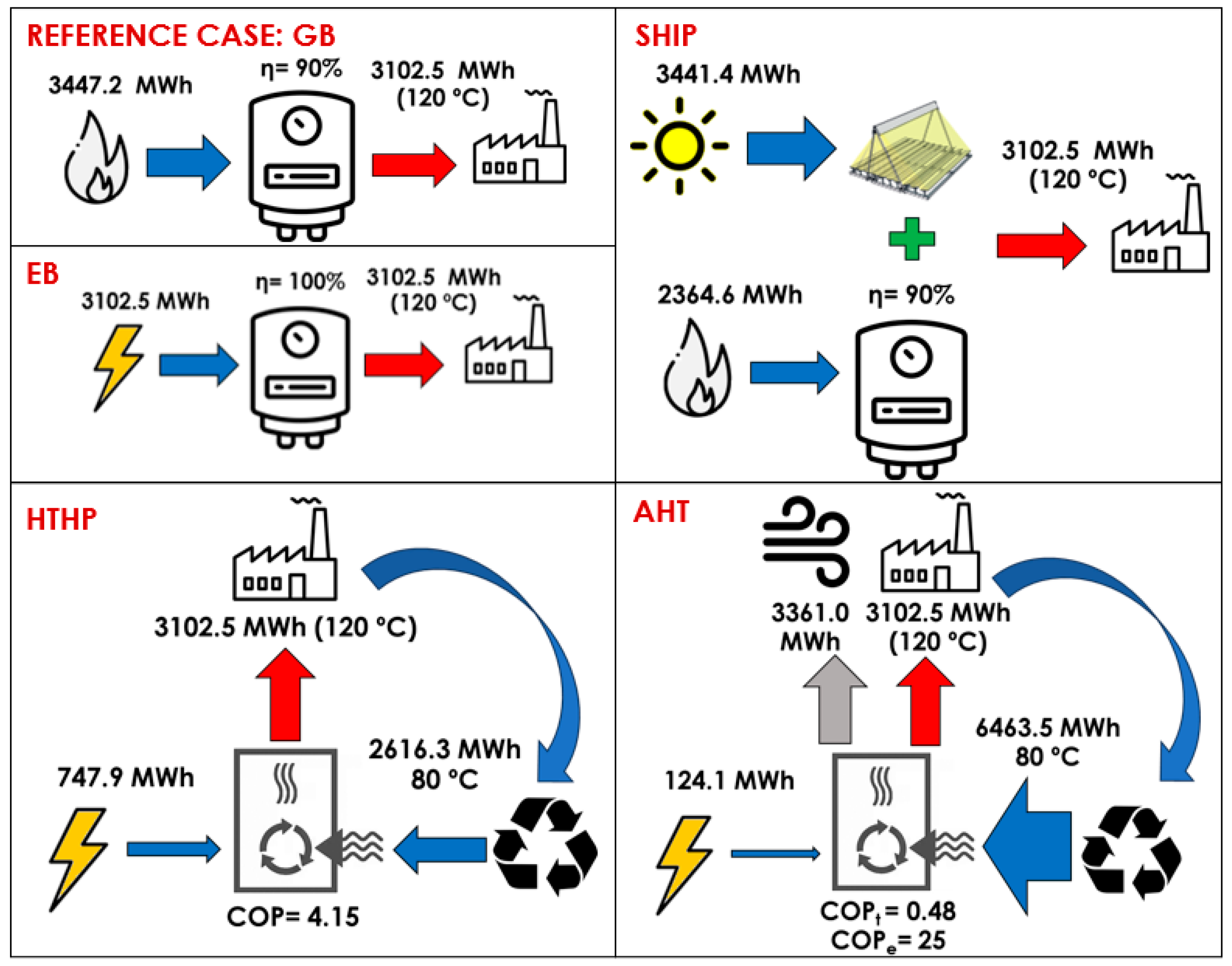
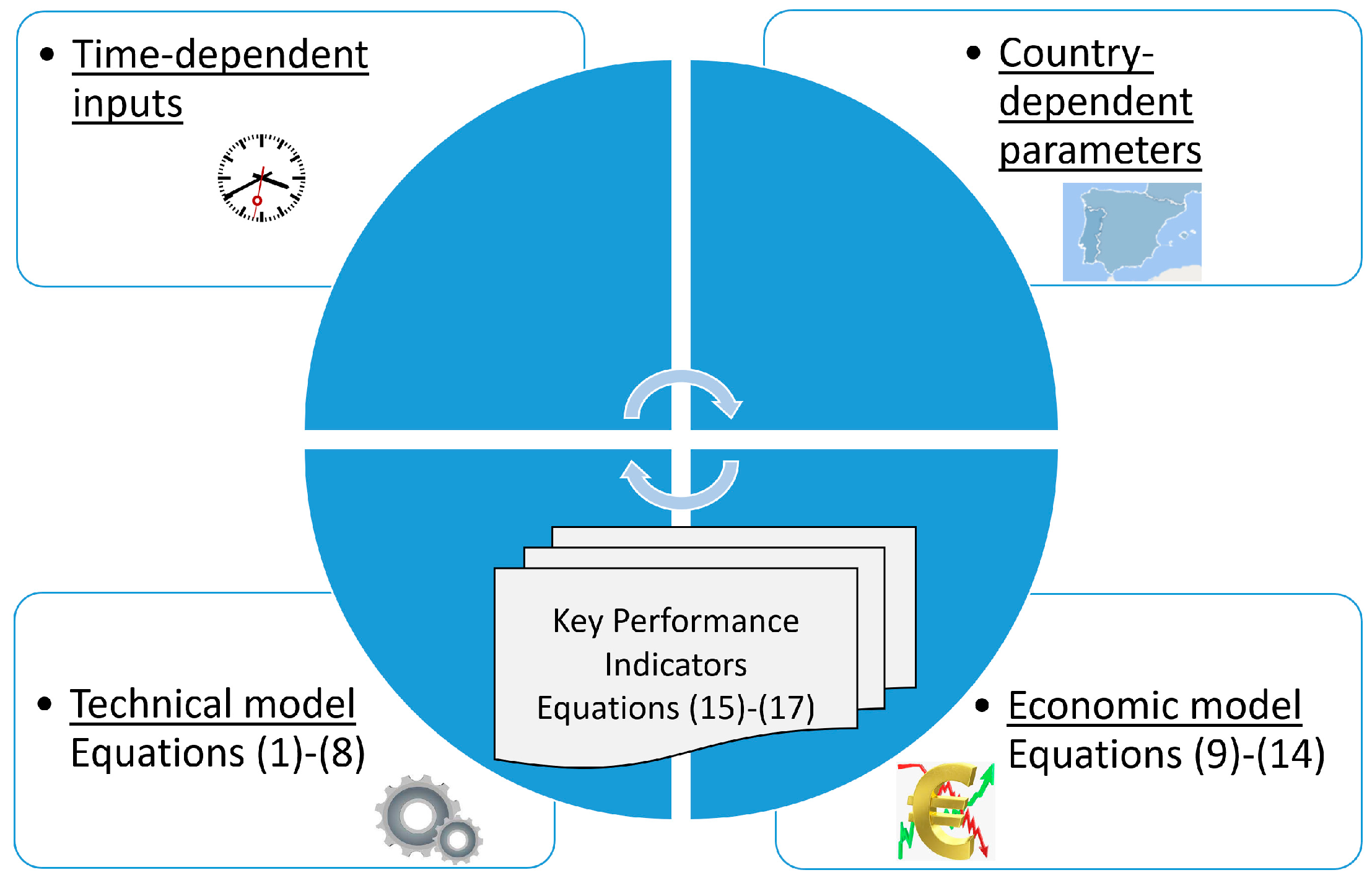
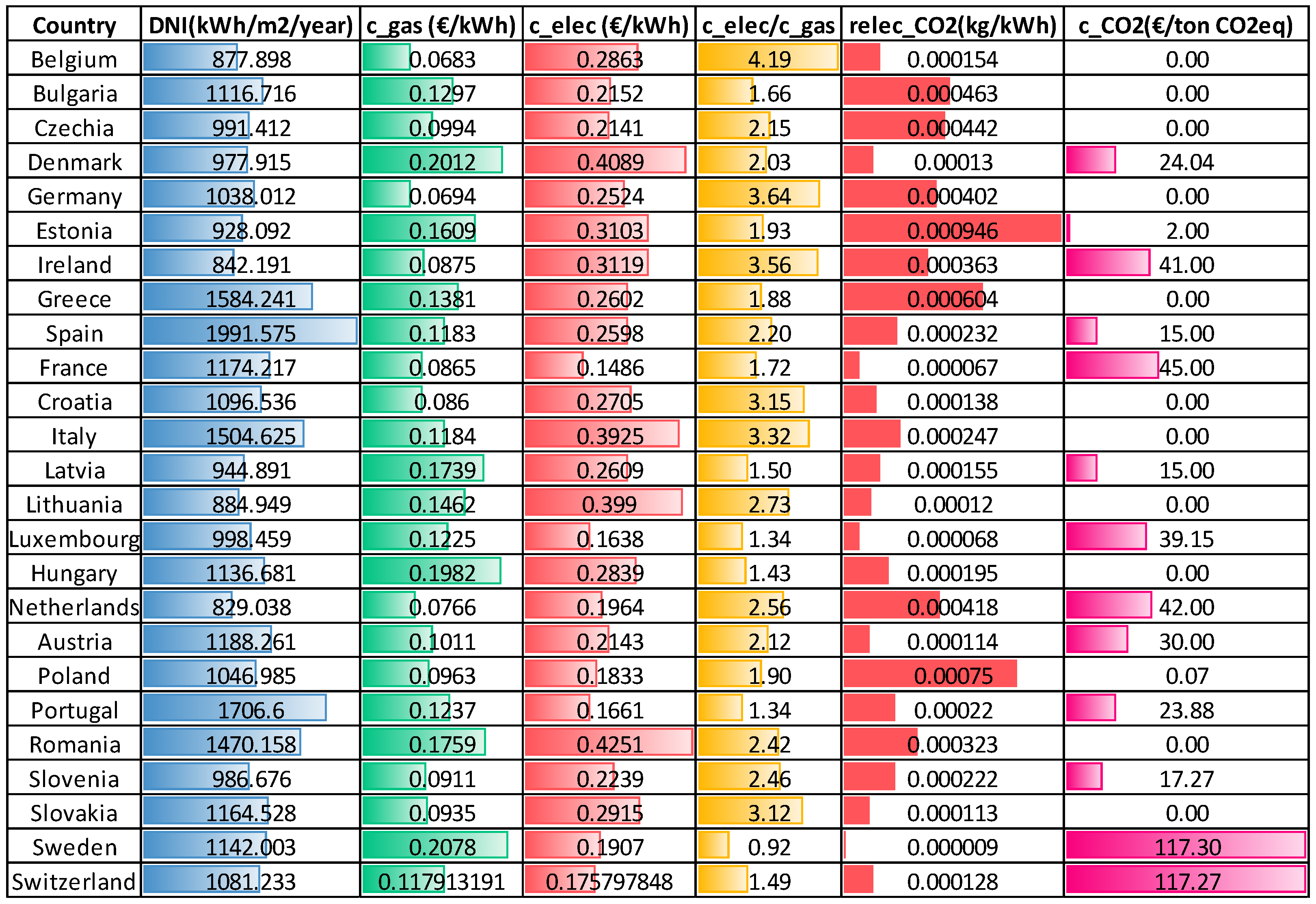



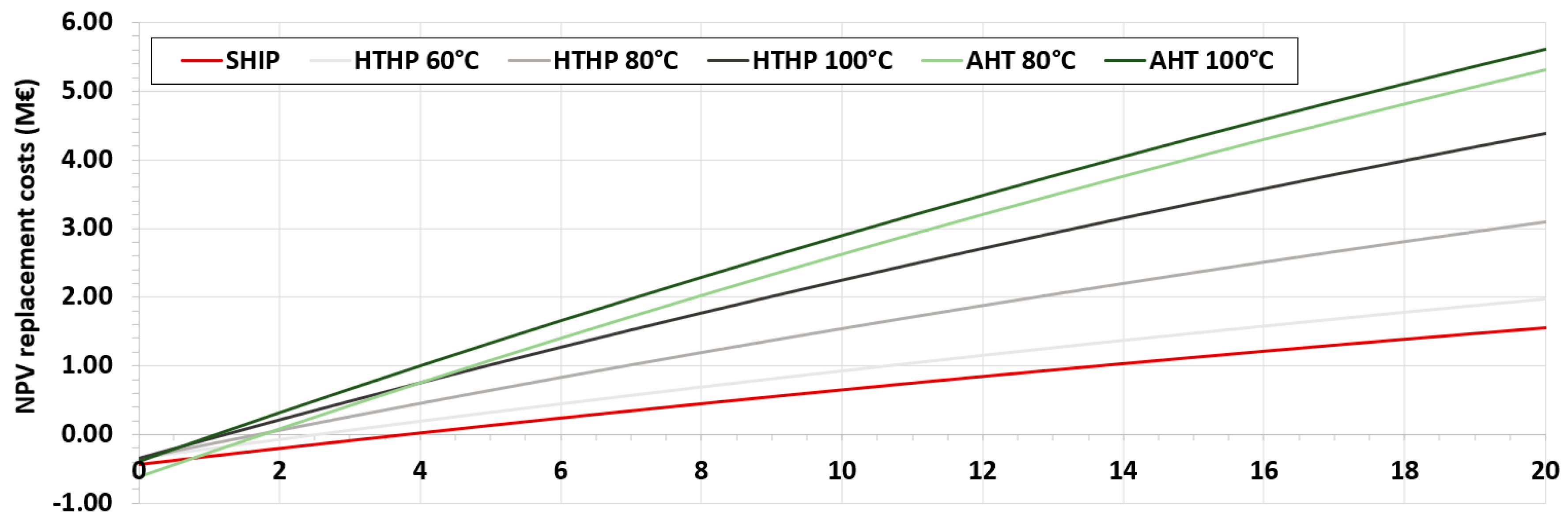
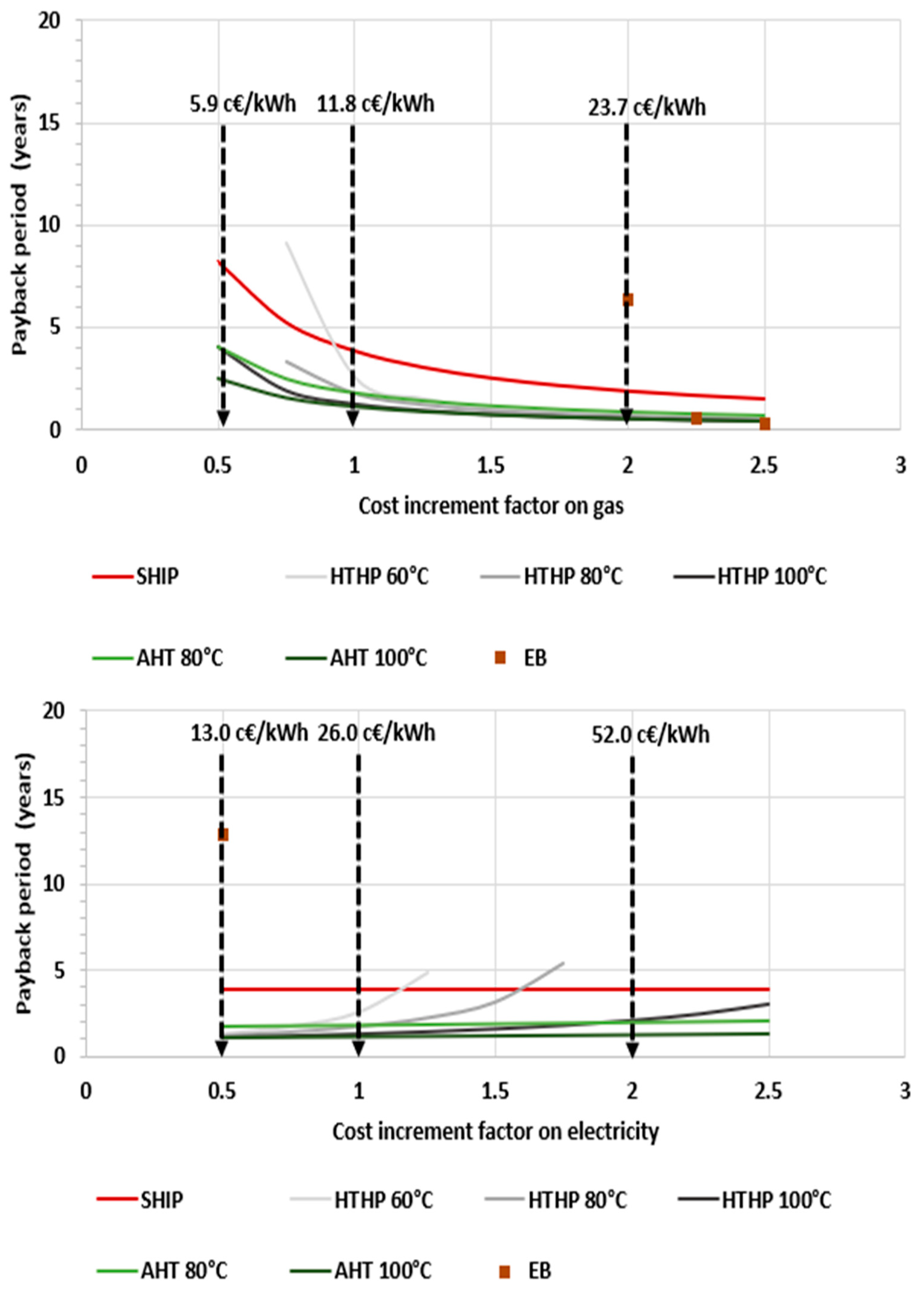

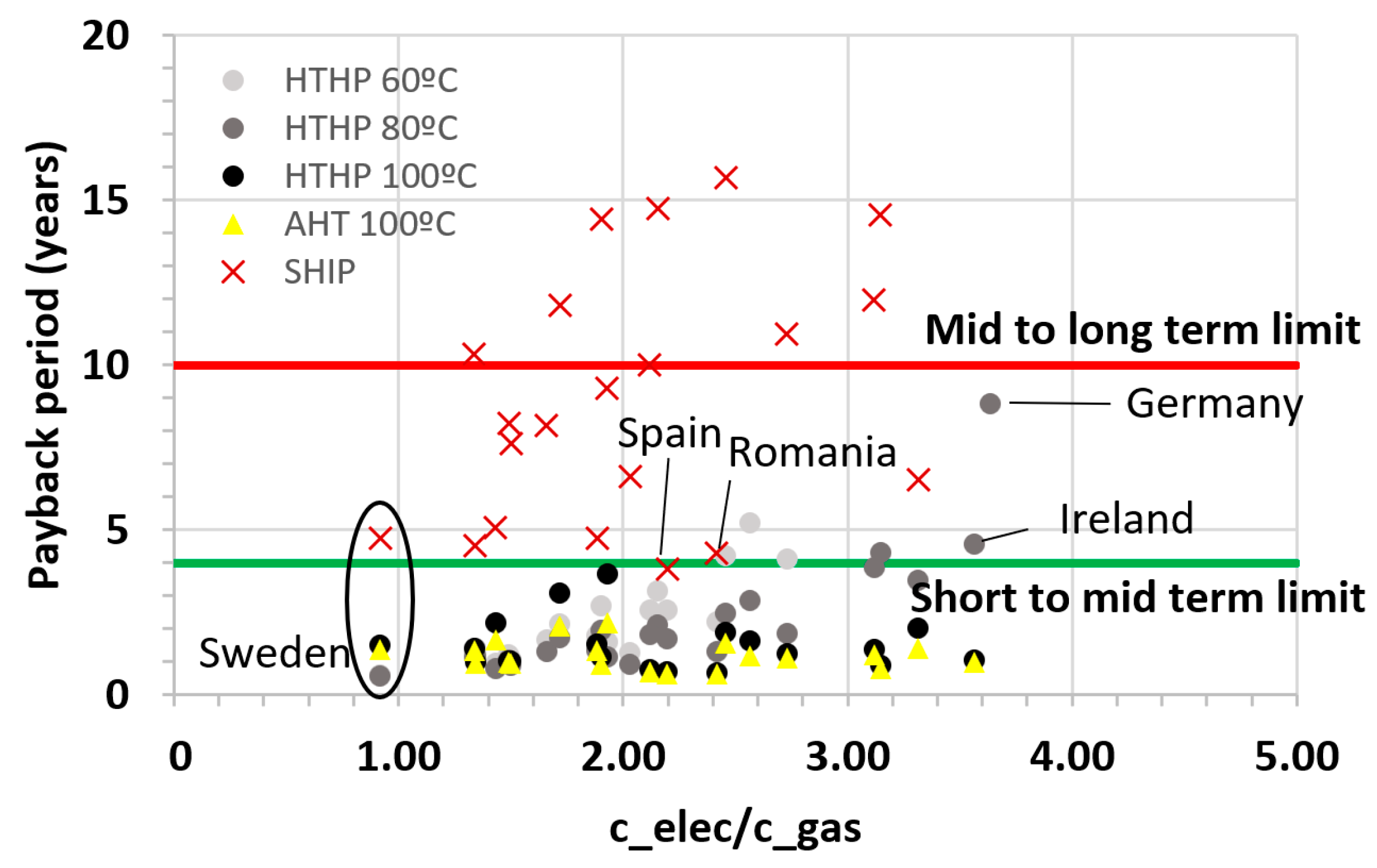
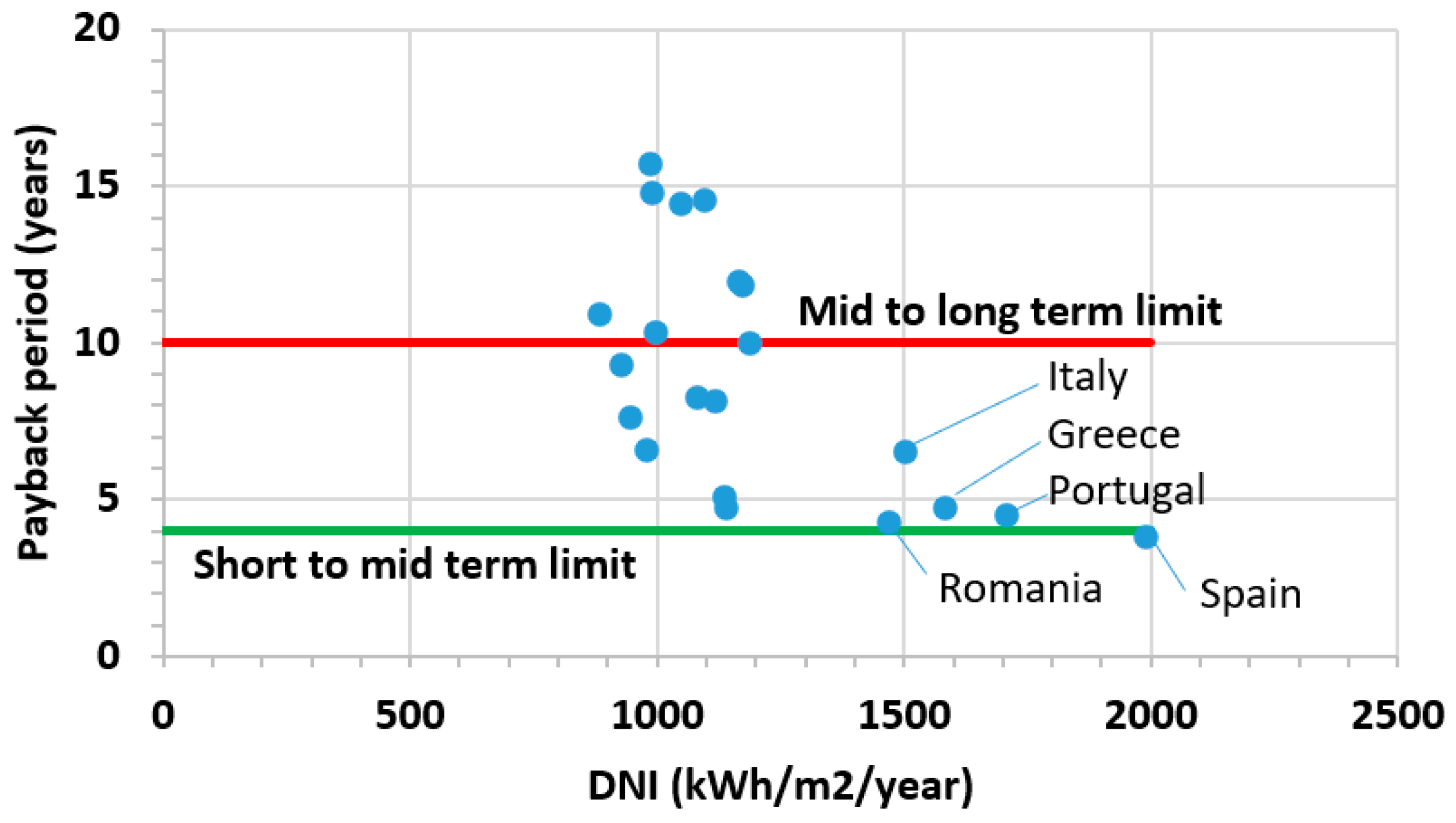
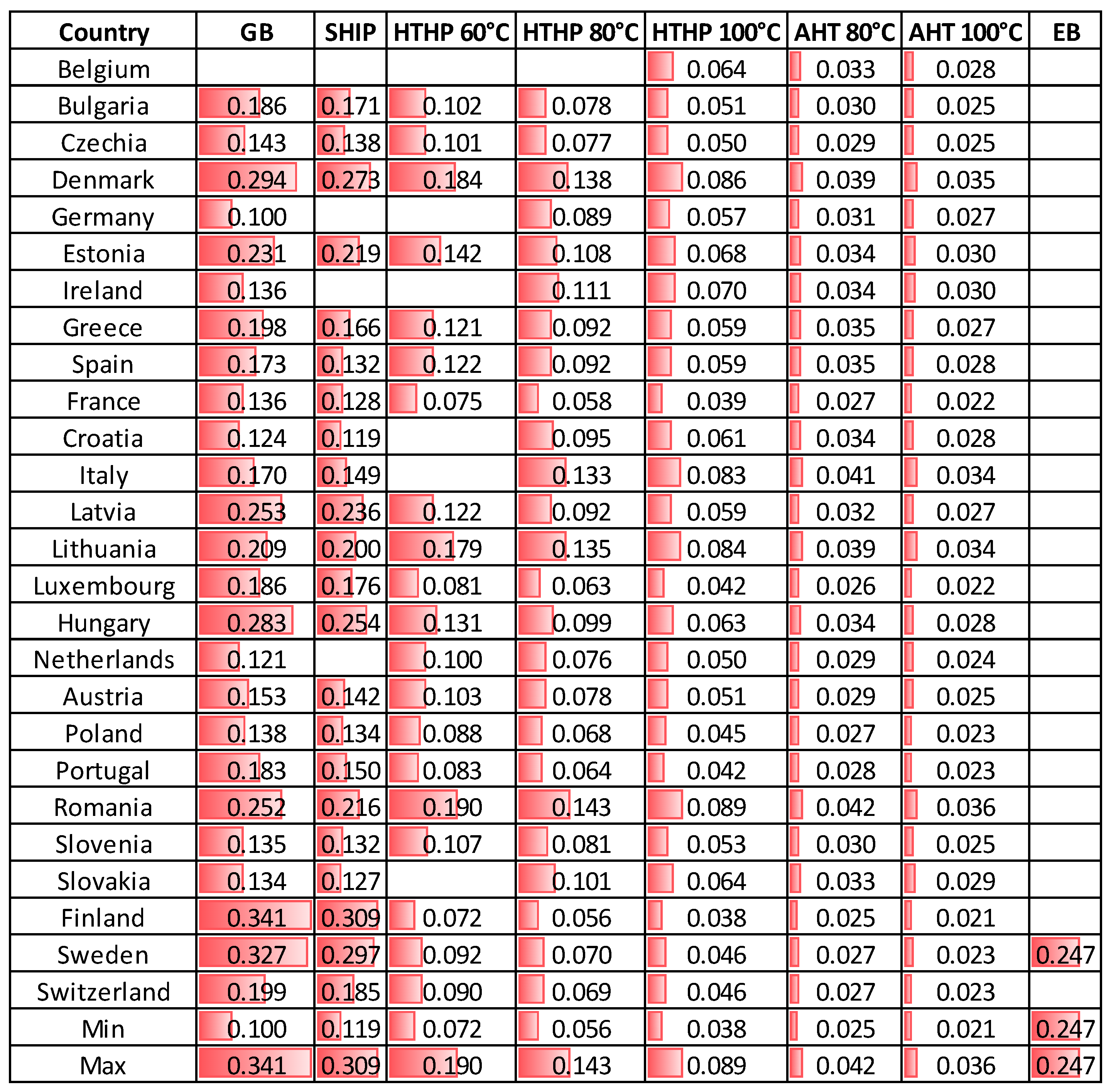
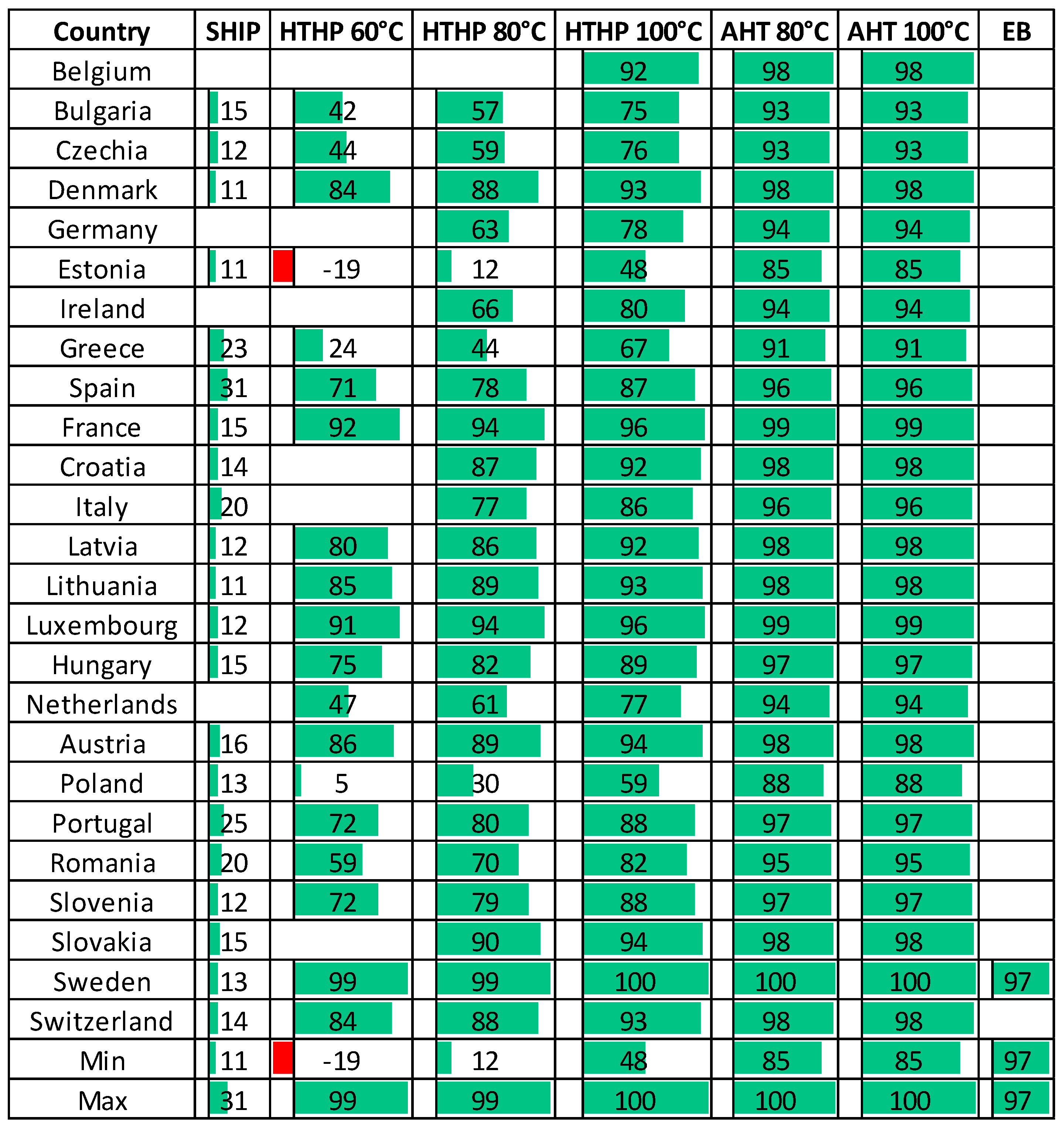
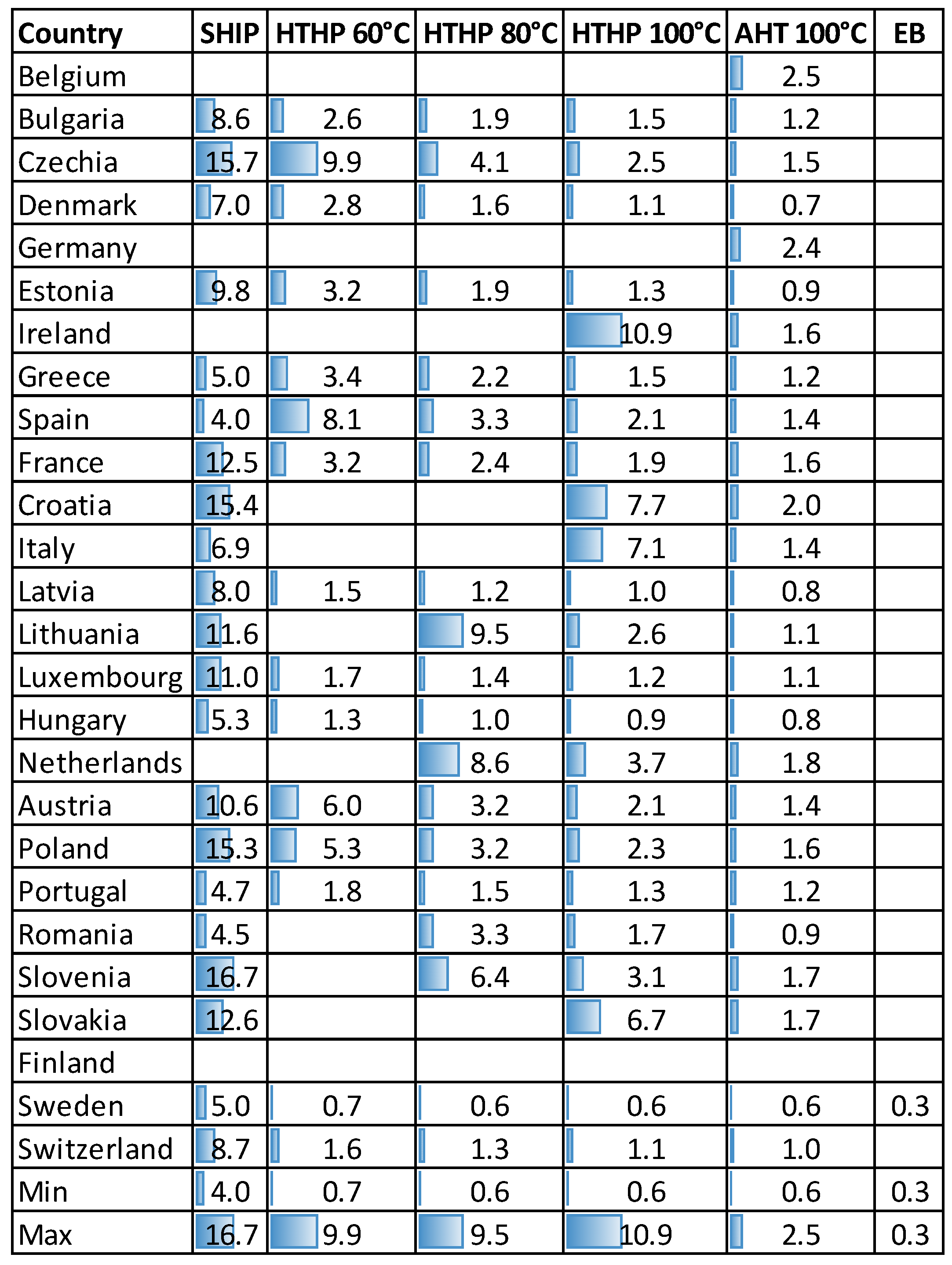
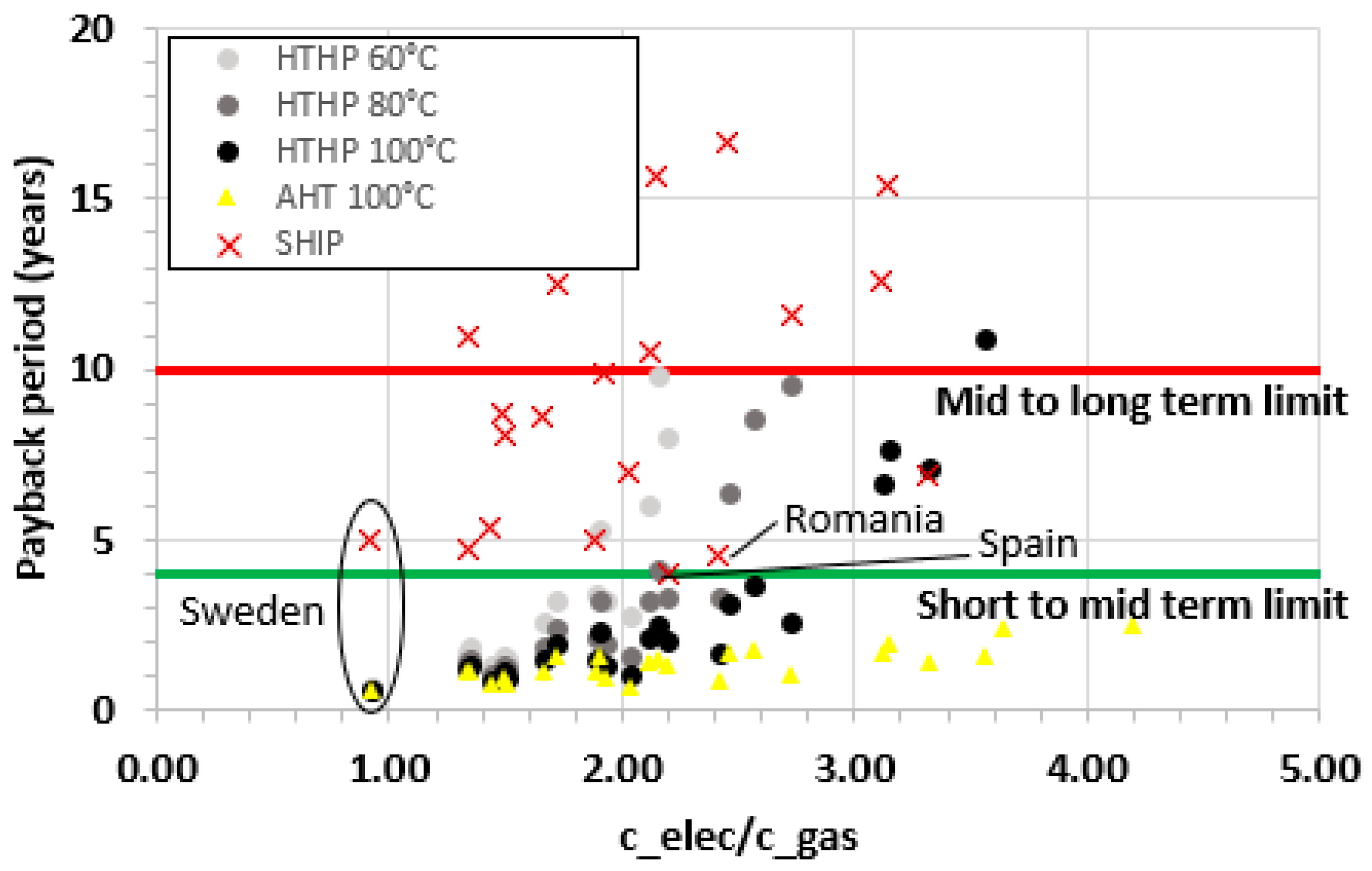
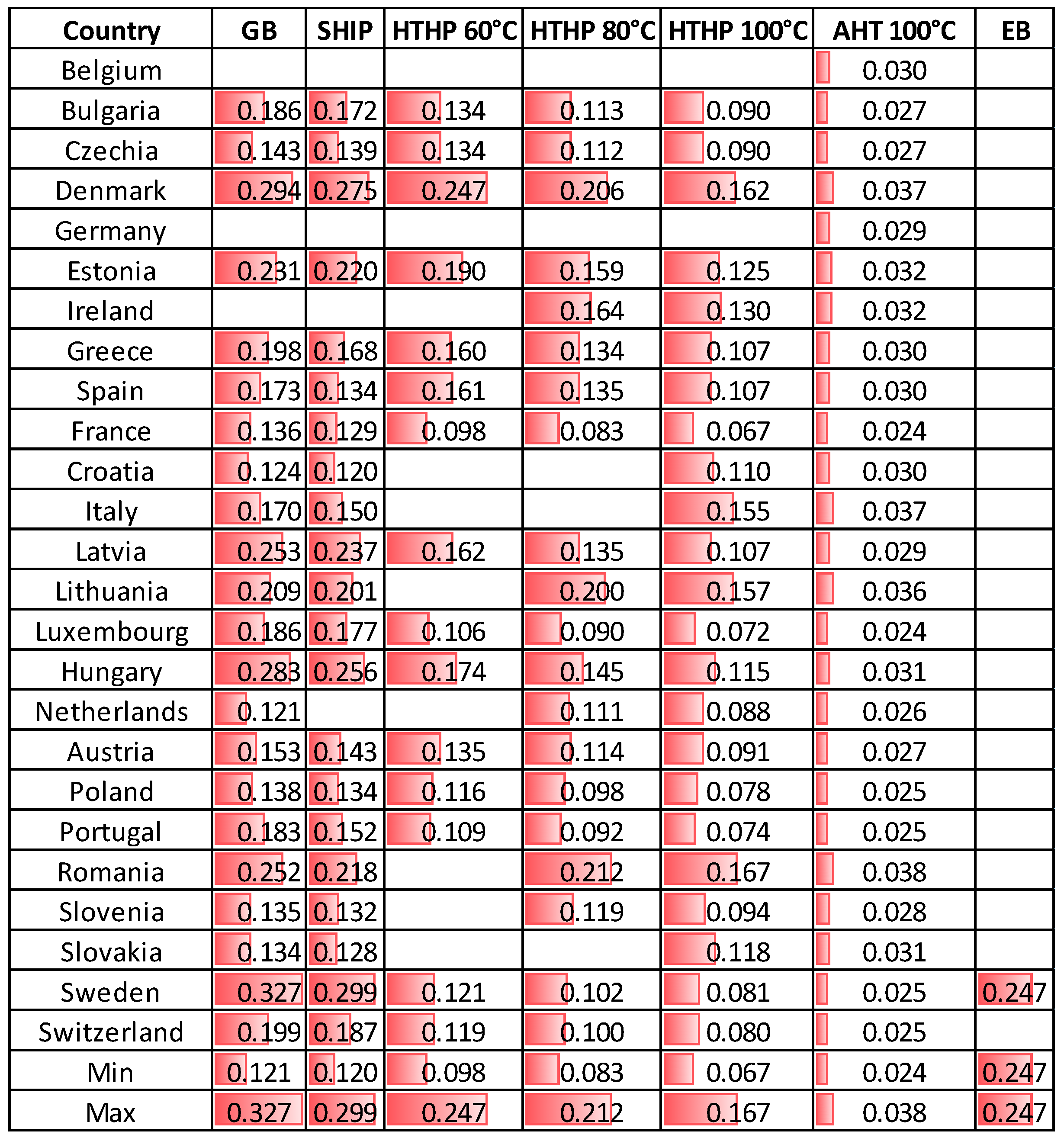
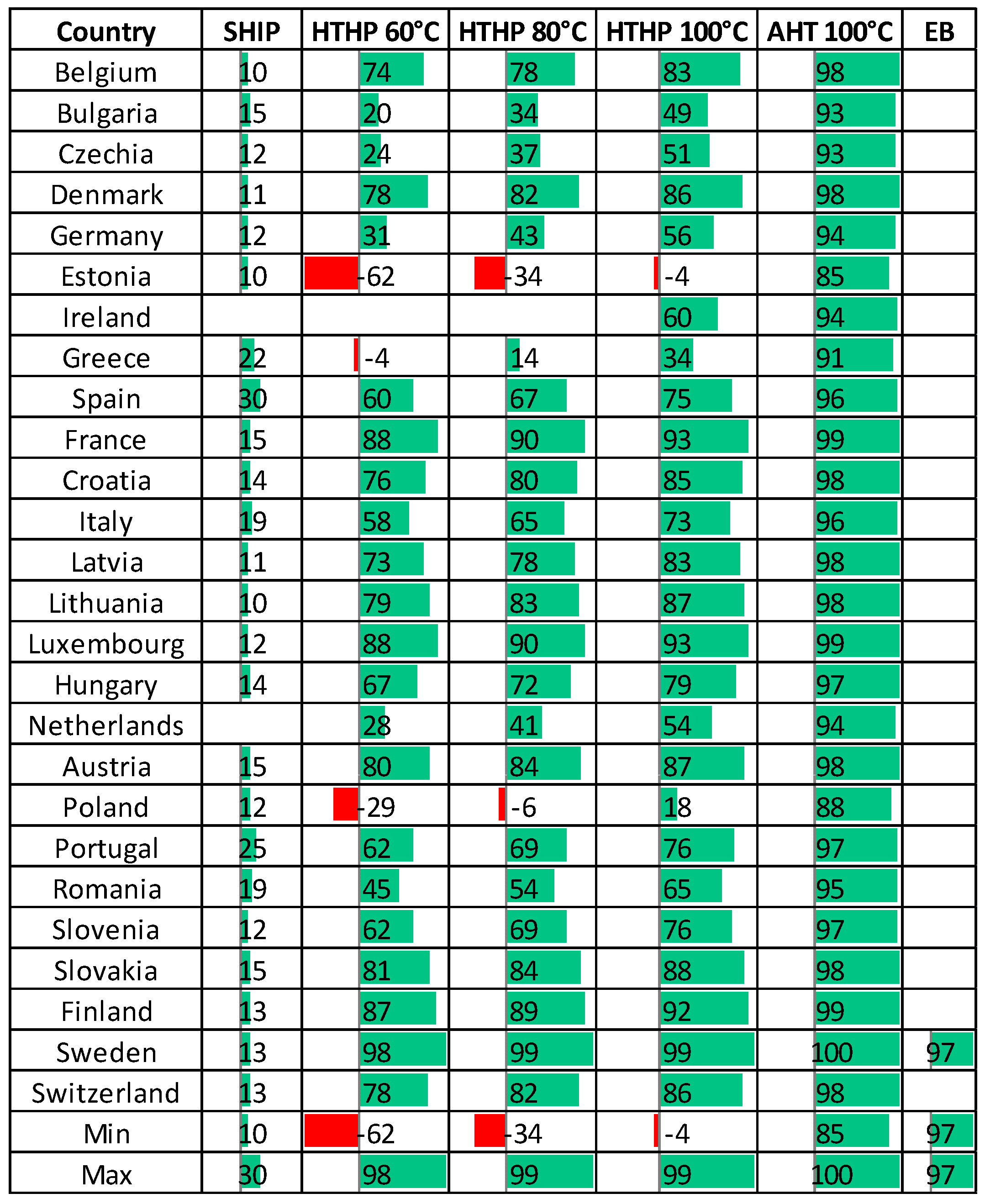
| Process Heat Temperature: 120 °C | Process Heat Temperature: 150 °C | ||||||
|---|---|---|---|---|---|---|---|
| Waste Heat Temperature (°C) | 60 | 80 | 100 | 60 | 80 | 100 | |
| Technology | GB |  |  |  |  |  |  |
| EB |  |  |  |  |  |  | |
| SHIP |  |  |  |  |  |  | |
| HTHP |  |  |  |  |  |  | |
| AHT |  |  |  |  |  |  | |
| Parameter | Value |
|---|---|
| Analysis period | 20 years [10,13,15,24,46] |
| Discount rate (d) | 5% [10,47] |
| Inflation on gas (igas) | 3% [24] |
| Inflation on electricity (ielec) | 3% [24] |
| Specific cost of GB (cgas_boiler) | 70 EUR/kW [48] |
| Specific cost of HTHP (cHTHP) | 700 EUR/kW [30] |
| Specific cost of SHIP system (cSHIP) | 300 EUR/m2 [12] |
| Specific cost of EB (cEB) | 120 EUR/kW [48,49] |
Disclaimer/Publisher’s Note: The statements, opinions and data contained in all publications are solely those of the individual author(s) and contributor(s) and not of MDPI and/or the editor(s). MDPI and/or the editor(s) disclaim responsibility for any injury to people or property resulting from any ideas, methods, instructions or products referred to in the content. |
© 2024 by the authors. Licensee MDPI, Basel, Switzerland. This article is an open access article distributed under the terms and conditions of the Creative Commons Attribution (CC BY) license (https://creativecommons.org/licenses/by/4.0/).
Share and Cite
Payá, J.; Cazorla-Marín, A.; Arpagaus, C.; Corrales Ciganda, J.L.; Hassan, A.H. Low-Pressure Steam Generation with Concentrating Solar Energy and Different Heat Upgrade Technologies: Potential in the European Industry. Sustainability 2024, 16, 1733. https://doi.org/10.3390/su16051733
Payá J, Cazorla-Marín A, Arpagaus C, Corrales Ciganda JL, Hassan AH. Low-Pressure Steam Generation with Concentrating Solar Energy and Different Heat Upgrade Technologies: Potential in the European Industry. Sustainability. 2024; 16(5):1733. https://doi.org/10.3390/su16051733
Chicago/Turabian StylePayá, Jorge, Antonio Cazorla-Marín, Cordin Arpagaus, José Luis Corrales Ciganda, and Abdelrahman H. Hassan. 2024. "Low-Pressure Steam Generation with Concentrating Solar Energy and Different Heat Upgrade Technologies: Potential in the European Industry" Sustainability 16, no. 5: 1733. https://doi.org/10.3390/su16051733







